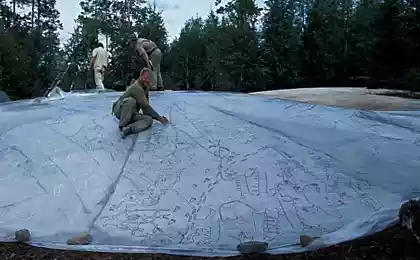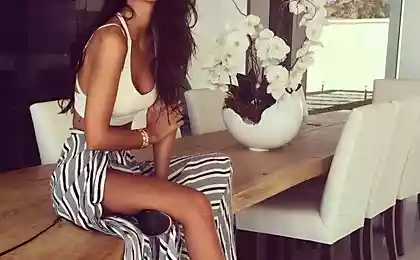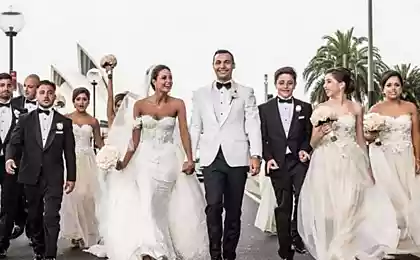1091
Secrets petroglyphs Galicia
From prehistoric times carved in stone symbols convey to us the following thoughts and beliefs of our Western European ancestors.

On the ancient stones carved holes and rings, spirals and other patterns, as well as images of deer, hunters, warriors and weapons.

House "palloza" in eastern Galicia, the descendants of the Iron Age round houses.
The age of these characters carved in stone, called petroglyphs, determined with difficulty. However, in Galicia, in northwestern Spain, the engraved images of objects, whose age is known about, for example Bronze Age swords. Many of the artifacts are not far from the Bronze Age settlements, and radiocarbon analysis carved in stone hearths, too, points to the Bronze Age. Thus, the image of Galicia probably made in the Bronze Age.

Petroglyph with circles and lines, Vigo, Spain.
Prehistoric patterns
Petroglyphs are found throughout Europe, and our team plans to visit many of these places. We have already visited Liptsy near Montenegro, where a steep cliff is decorated with scenes from the life of the deer. On it you can see the image of the deer males and females with protruding horns, scattered in a natural way, as if they saw the hunter, as well as symbols of the swastika and the squares, the cross divided into four parts. It is believed that the petroglyphs are in Lipce 800 BC, but they have much in common with the Galician, which clearly date from the Bronze Age.
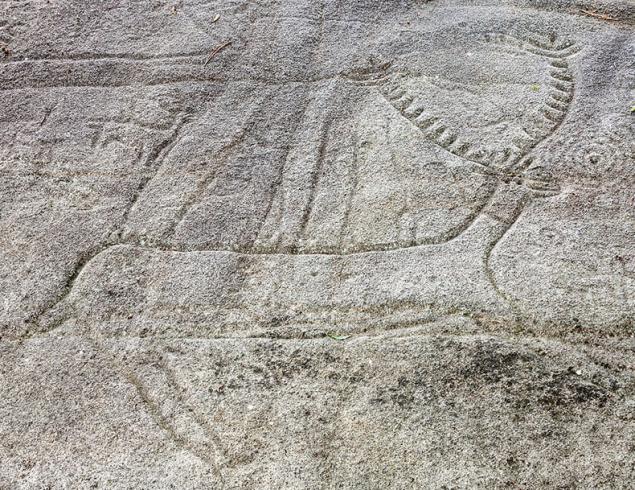
Petroglyph in Campo Lameyro. Galicia, Spain.

Part of the cliff in Lipce, Montenegro, on which the symbols of the swastika can be seen.

Stag and doe in Lipce, Montenegro.
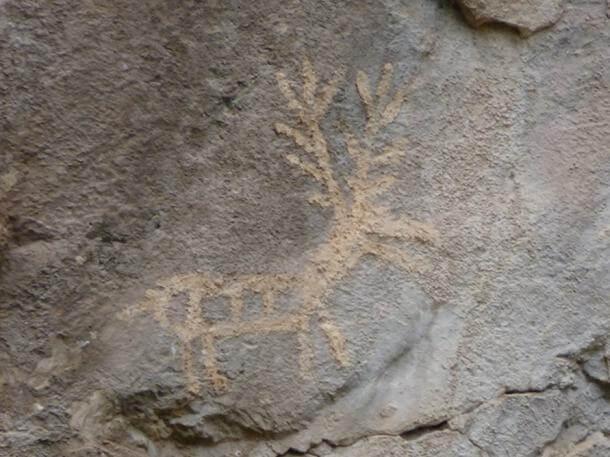
Deer in Lipce, Montenegro
Many, though not all, images are found close enough to the sea. Geology is a factor in their distribution, because for stone art requires flat surface soft enough to resist the engraving. Used equipment similar to the one that is widely used on the walls of the cave during the Ice Age. Circuit charted sharp quartz line and then deepened in the u-shaped grooves with stone hammers. The remains of these tools have been found in caves near the petroglyphs. Sometimes the faces are smoothed thread, although it is difficult to determine, it happened intentionally or under the influence of time and weather.
A variety of petroglyphs Galicia
Petroglyphs are found throughout Galicia, but the maximum density is achieved along the Atlantic coast. In Campo Lameyro you can visit the well-equipped pointers in the open-air museum, which is strewn with flat stones mountain landscape. On these stones our ancestors from the Bronze Age charted a wide variety of characters.
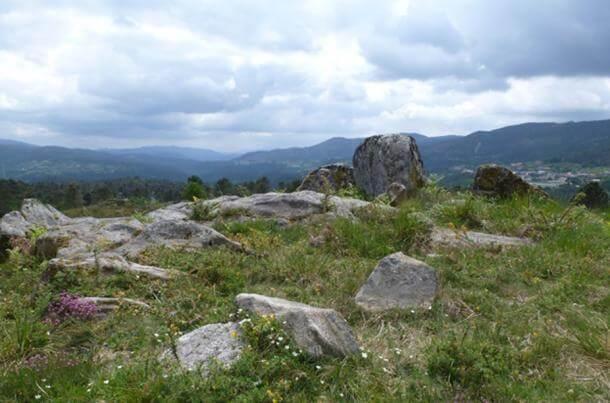
Landscape in Campo Lameyra - scattered nature of the flat stones as if inviting people to draw on them
Found in Galicia geometric patterns have much in common with the art of stone from other areas along the Atlantic coast - wells, spirals and concentric circles, some of the center held the line (they were called labyrinths). Also, there are squares with rounded edges, grids, zigzags, swastikas and Triskelion (like trёhnogy symbol on flag of Maine Islands). However, some of the motifs found only in Galicia - deer, animals and riders, the snake boats and weapons
.
The snake carved in stone in the Castro de Tron: it is unknown whether it is in the Iron Age and later created
Hunting
There are images of horses, sometimes with riders, as «Laxe dos Cabalos», the famous stone from the Campo Lameyro, although here the picture is very simple and neotchёtlivoe. If these images belong to the Bronze Age, when they are sufficiently well with the current theory that the bronze processing and riding spread across Europe with immigrants, whose origin lies in the original lands of the pit culture, north of the Black Sea.
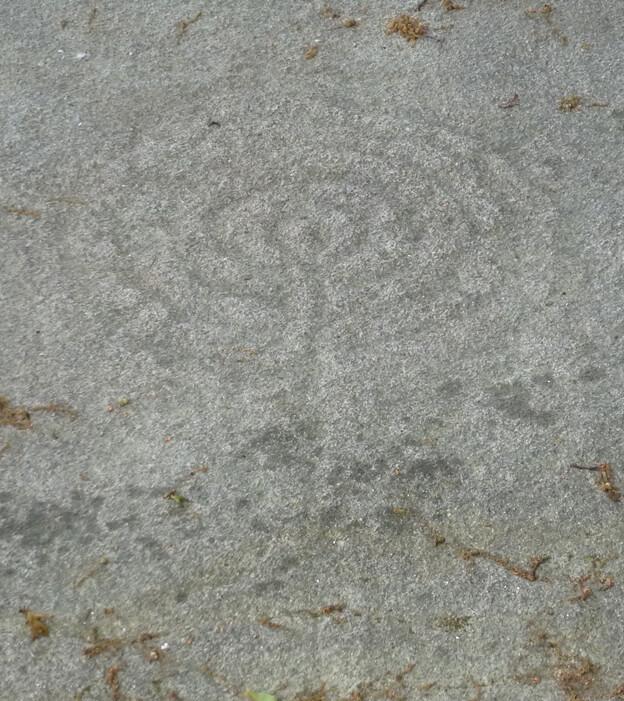
One of the "maze" in Campo Lameyro Galicia. Unfortunately, we got there on a cloudy day, and the photo turned out not so clear, as if the sun was shining, but still is not bad for the image comes from the Bronze Age!
Deer appear much more frequently. Sometimes they painted a group, representing the natural herd. Sometimes depicts a male and a female artist - autumn run of the eyes of our ancestors from the Bronze Age. Some images are interpreted as meeting the female and male. The most impressive deer also depicted on «Laxe dos Carballos». It is located next to two "Labyrinth" and his back pierced by six lines, no doubt depicting a spear.
In some scenes depict people, such as a rock bar in Nabala de Martinho depicts a man holding a gun.
Meets and weapons, the most striking example - on a wide rock in da Auga Laze near Gondomar. It accurately determined aspiring up the swords and halberds of the Bronze Age, and a number of boards.
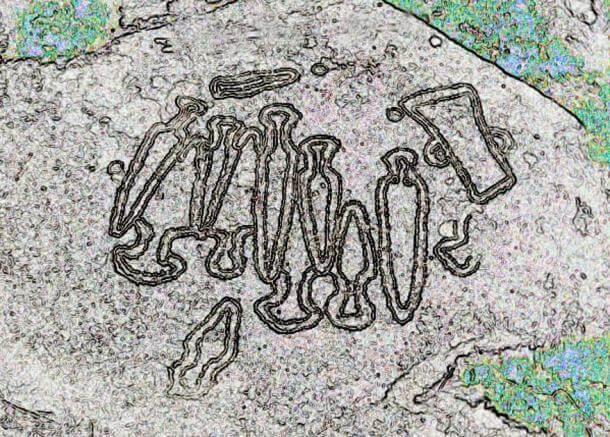
Digitized Photo weapons contours on a rock with petroglyphs in Galicia, Spain
Stories about exploits and mythological battle
Such images may be for the glorification of weapons and hunting and gathering places were created in the hunters and warriors, where they were trained and told stories about the true courage, and maybe, retold the legend of bygone battles. Perhaps even that it was a place of prayer on the hunting success and well-being of the tribe.
In any event, there is obviously the predominance of men and male activity, and these stones are very eloquently tell us about the transformation of the matriarchal society (which is characterized by the image of women) in the company of male dominance, received spread with the advent of metal processing. Around the same time in the worship of goddesses Galicia replaced the worship of the gods.
Shamanic trance
Sometimes deer images are not completed and the semi-pattern often associated with cracks in the rocks, and images of spirals and zigzags. In these cases, we can assume that there were taken hallucinogenic mushrooms or poppy. (Poppy heads were found during archaeological excavations near the Portuguese border, so this idea is not so unfounded).
Geometric patterns on the stones resemble internal patterns of our brain being vacated during the trance or taking drugs. Deer can be seen as messengers between the worlds emerging from the world of spirits and disappearing in it.

Circles and labyrinths carved in stone in Galicia, Spain
Some Galician archaeologists believe that these figures represent the journey of the human spirit in the afterlife. On the stone «Outeiro dos Cogoludos» in Campo Lameyro there is an image that can be interpreted as an animal emerging from a combination of circles, possibly leaving the other world.
We can not be sure of the goal of Galician petroglyphs, but there is no doubt as to their importance to the Bronze Age society that once flourished here. And how our ancestors dealt with through the surface of the stone spirits of the world, and we are on the elusive moment touched last through the image left by them.

On the ancient stones carved holes and rings, spirals and other patterns, as well as images of deer, hunters, warriors and weapons.

House "palloza" in eastern Galicia, the descendants of the Iron Age round houses.
The age of these characters carved in stone, called petroglyphs, determined with difficulty. However, in Galicia, in northwestern Spain, the engraved images of objects, whose age is known about, for example Bronze Age swords. Many of the artifacts are not far from the Bronze Age settlements, and radiocarbon analysis carved in stone hearths, too, points to the Bronze Age. Thus, the image of Galicia probably made in the Bronze Age.

Petroglyph with circles and lines, Vigo, Spain.
Prehistoric patterns
Petroglyphs are found throughout Europe, and our team plans to visit many of these places. We have already visited Liptsy near Montenegro, where a steep cliff is decorated with scenes from the life of the deer. On it you can see the image of the deer males and females with protruding horns, scattered in a natural way, as if they saw the hunter, as well as symbols of the swastika and the squares, the cross divided into four parts. It is believed that the petroglyphs are in Lipce 800 BC, but they have much in common with the Galician, which clearly date from the Bronze Age.

Petroglyph in Campo Lameyro. Galicia, Spain.

Part of the cliff in Lipce, Montenegro, on which the symbols of the swastika can be seen.

Stag and doe in Lipce, Montenegro.

Deer in Lipce, Montenegro
Many, though not all, images are found close enough to the sea. Geology is a factor in their distribution, because for stone art requires flat surface soft enough to resist the engraving. Used equipment similar to the one that is widely used on the walls of the cave during the Ice Age. Circuit charted sharp quartz line and then deepened in the u-shaped grooves with stone hammers. The remains of these tools have been found in caves near the petroglyphs. Sometimes the faces are smoothed thread, although it is difficult to determine, it happened intentionally or under the influence of time and weather.
A variety of petroglyphs Galicia
Petroglyphs are found throughout Galicia, but the maximum density is achieved along the Atlantic coast. In Campo Lameyro you can visit the well-equipped pointers in the open-air museum, which is strewn with flat stones mountain landscape. On these stones our ancestors from the Bronze Age charted a wide variety of characters.

Landscape in Campo Lameyra - scattered nature of the flat stones as if inviting people to draw on them
Found in Galicia geometric patterns have much in common with the art of stone from other areas along the Atlantic coast - wells, spirals and concentric circles, some of the center held the line (they were called labyrinths). Also, there are squares with rounded edges, grids, zigzags, swastikas and Triskelion (like trёhnogy symbol on flag of Maine Islands). However, some of the motifs found only in Galicia - deer, animals and riders, the snake boats and weapons
.

The snake carved in stone in the Castro de Tron: it is unknown whether it is in the Iron Age and later created
Hunting
There are images of horses, sometimes with riders, as «Laxe dos Cabalos», the famous stone from the Campo Lameyro, although here the picture is very simple and neotchёtlivoe. If these images belong to the Bronze Age, when they are sufficiently well with the current theory that the bronze processing and riding spread across Europe with immigrants, whose origin lies in the original lands of the pit culture, north of the Black Sea.

One of the "maze" in Campo Lameyro Galicia. Unfortunately, we got there on a cloudy day, and the photo turned out not so clear, as if the sun was shining, but still is not bad for the image comes from the Bronze Age!
Deer appear much more frequently. Sometimes they painted a group, representing the natural herd. Sometimes depicts a male and a female artist - autumn run of the eyes of our ancestors from the Bronze Age. Some images are interpreted as meeting the female and male. The most impressive deer also depicted on «Laxe dos Carballos». It is located next to two "Labyrinth" and his back pierced by six lines, no doubt depicting a spear.
In some scenes depict people, such as a rock bar in Nabala de Martinho depicts a man holding a gun.
Meets and weapons, the most striking example - on a wide rock in da Auga Laze near Gondomar. It accurately determined aspiring up the swords and halberds of the Bronze Age, and a number of boards.

Digitized Photo weapons contours on a rock with petroglyphs in Galicia, Spain
Stories about exploits and mythological battle
Such images may be for the glorification of weapons and hunting and gathering places were created in the hunters and warriors, where they were trained and told stories about the true courage, and maybe, retold the legend of bygone battles. Perhaps even that it was a place of prayer on the hunting success and well-being of the tribe.
In any event, there is obviously the predominance of men and male activity, and these stones are very eloquently tell us about the transformation of the matriarchal society (which is characterized by the image of women) in the company of male dominance, received spread with the advent of metal processing. Around the same time in the worship of goddesses Galicia replaced the worship of the gods.
Shamanic trance
Sometimes deer images are not completed and the semi-pattern often associated with cracks in the rocks, and images of spirals and zigzags. In these cases, we can assume that there were taken hallucinogenic mushrooms or poppy. (Poppy heads were found during archaeological excavations near the Portuguese border, so this idea is not so unfounded).
Geometric patterns on the stones resemble internal patterns of our brain being vacated during the trance or taking drugs. Deer can be seen as messengers between the worlds emerging from the world of spirits and disappearing in it.

Circles and labyrinths carved in stone in Galicia, Spain
Some Galician archaeologists believe that these figures represent the journey of the human spirit in the afterlife. On the stone «Outeiro dos Cogoludos» in Campo Lameyro there is an image that can be interpreted as an animal emerging from a combination of circles, possibly leaving the other world.
We can not be sure of the goal of Galician petroglyphs, but there is no doubt as to their importance to the Bronze Age society that once flourished here. And how our ancestors dealt with through the surface of the stone spirits of the world, and we are on the elusive moment touched last through the image left by them.
Joe Dispenza: materialization of the events in your life begins at the quantum level
How to get out of the position of trouble














